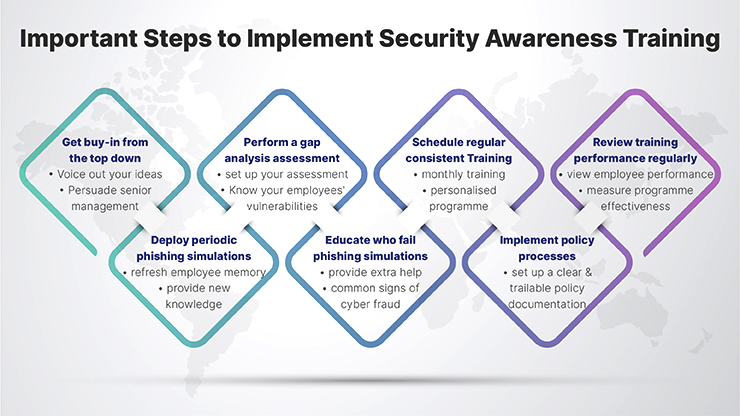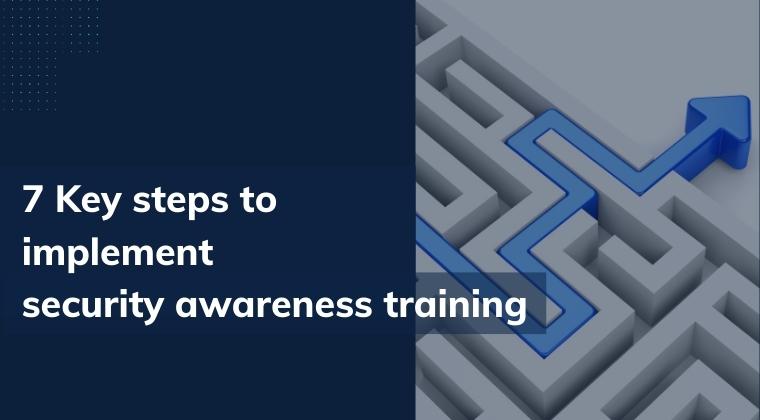
Introduction
Definition of Cybersecurity Awareness Program
A Cybersecurity Awareness Program is designed to educate individuals about the importance of cybersecurity, the potential threats they may encounter, and the best practices to mitigate these risks. It encompasses training sessions, workshops, and resources that aim to empower employees and users to recognize and respond effectively to cybersecurity challenges. This program serves as a proactive defense mechanism, ensuring that everyone is equipped with the knowledge required to protect sensitive information.
By fostering a culture of security mindfulness, organizations can significantly reduce the likelihood of breaches caused by human error. Personal experiences illustrate this; a friend of mine nearly fell victim to a phishing scam simply because they were unaware of the warning signs. This is a common scenario that underscores the value of having a solid cybersecurity awareness program in place.
Significance of Cybersecurity Awareness
The significance of cybersecurity awareness cannot be overstated. With cyber threats evolving constantly, awareness becomes the first line of defense. Consider the following points:
- Protection against threats: Employees who understand the threats can avoid risky behaviors.
- Incident response: Prepared individuals can respond quickly to suspicious activities.
- Building a security culture: Awareness fosters a security-first mindset across the organization.
In a rapidly digitizing world, cultivating a knowledgeable workforce is essential. As businesses like TECHFACK emphasize, effective cybersecurity awareness paves the way for safer interactions and security-savvy employees.

Assessing Risks and Needs
Identifying Potential Threats
Once an organization recognizes the importance of a Cybersecurity Awareness Program, the next vital step is assessing risks and needs. Identifying potential threats is a critical component of this process. It’s essential to understand the various types of attacks that could target your systems, including:
- Phishing Attacks: Deceptive emails that trick users into revealing sensitive information.
- Malware: Malicious software designed to disrupt or gain unauthorized access to networks.
- Ransomware: A type of malware that locks users out of their systems until a ransom is paid.
- Social Engineering: Manipulating individuals into divulging confidential information.
Reflecting on a recent incident at a local business, they found employees regularly clicking on links in unsolicited emails. This lack of awareness highlighted a significant threat that could be tackled through effective training.
Evaluating Current Security Measures
The next part of this assessment involves evaluating current security measures. Organizations should review existing protocols:
- Firewalls: Are they up-to-date and properly configured?
- Access Controls: Who has access to sensitive information, and is this access necessary?
- Incident Response Plans: Is there a plan in place if a breach occurs?
By examining these elements, companies can identify gaps in their defense mechanisms and tailor training based on real vulnerabilities. This strategic approach ensures that the Cybersecurity Awareness Program addresses identified risks, leading to a more secure environment.

Planning Your Program
Setting Objectives and Goals
After thoroughly assessing risks and needs, it’s time to turn to the planning phase of your Cybersecurity Awareness Program. A crucial starting point is setting clear objectives and goals. This foundational step helps provide direction and focus for your training initiatives. Consider establishing objectives such as:
- Increasing awareness of phishing attacks: Aim for employees to recognize and avoid suspicious emails.
- Strengthening password protocols: Educate staff on creating complex passwords and the importance of password managers.
- Reducing security incidents: Set a measurable goal to decrease the number of reported incidents by a specified percentage within a year.
For example, a colleague of mine implemented a similar program, initially aiming for a 30% reduction in security incidents in six months. Their focused approach made a noticeable difference!
Defining Target Audience
Once objectives are set, it’s essential to define your target audience. Different employee groups may have varying levels of exposure and experience with cybersecurity threats. Segment your audience based on:
- Roles and Responsibilities: Tailor content for IT staff, management, and regular employees, reflecting their specific risks and needs.
- Experience Levels: Consider beginner, intermediate, and advanced users to customize training accordingly.
Taking the time to understand who will benefit from the program allows for personalized engagement, enhancing the overall effectiveness of your awareness initiatives. After all, a well-informed workforce is the best defense against evolving cyber threats!

Designing Awareness Activities
Training Workshops and Seminars
With clear objectives and a defined target audience in place, it’s time to dive into the exciting phase of designing awareness activities. One effective method is organizing training workshops and seminars. These interactive sessions provide participants with hands-on experience and foster open discussion about cybersecurity issues. Consider including:
- Role-Playing Scenarios: Engage employees by simulating phishing attacks or social engineering attempts, enabling them to practice their responses.
- Expert Guest Speakers: Invite cybersecurity professionals to share real-life experiences, making the threats more relatable and tangible.
A friend of mine attended a cybersecurity workshop where they could directly simulate attacks. This practical approach not only enhanced their understanding of risks but also made the learning process enjoyable.
Creating Educational Materials
In addition to workshops, developing educational materials is crucial for reinforcing key concepts. These materials can take various forms, such as:
- Quick Reference Guides: Summarize essential tips for identifying phishing emails or safe browsing practices.
- Infographics: Visually represent statistics and procedures to make information easily digestible.
These resources can be disseminated via email newsletters, posters in common areas, or an internal website. By combining engaging activities with informative materials, organizations can effectively elevate cybersecurity awareness, ensuring employees are well-equipped to combat potential threats.

Implementing the Program
Communication and Promotion Strategies
With the design phase complete, the focus now shifts to implementing your Cybersecurity Awareness Program effectively. A key aspect of successful implementation involves using strong communication and promotion strategies. To ensure employees engage and participate, consider the following approaches:
- Kickoff Events: Launch your program with an exciting event, complete with engaging presentations to generate enthusiasm.
- Regular Updates: Keep the momentum going by sending out newsletters or updates that share new tips or highlight recent trends in cybersecurity.
- Incentives and Rewards: Motivate employees by incorporating gamification; for instance, offer prizes for those who complete training modules or recognize the most security threats.
For example, a colleague of mine introduced a monthly cybersecurity quiz with prizes, sparking healthy competition and increased participation across the organization.
Training Delivery Methods
When it comes to training delivery methods, flexibility is crucial. Different individuals may respond better to various formats. Here are some popular options:
- In-Person Workshops: These allow for interaction and immediate feedback.
- Online E-Learning Modules: Perfect for accommodating busy schedules and enabling self-paced learning.
- Webinars: Great for reaching a dispersed audience while providing live interaction with experts.
By employing a mix of these delivery methods, organizations can create an inclusive and effective learning environment. This adaptability helps ensure that all employees comprehend and retain the crucial cybersecurity information they need.

Monitoring and Evaluation
Tracking Progress and Metrics
Once your Cybersecurity Awareness Program is up and running, it’s essential to establish a robust system for monitoring and evaluation. Tracking progress and metrics is key to understanding how effectively your program is performing. You might consider the following metrics:
- Participation Rates: Monitor how many employees are engaging in workshops or completing e-learning modules.
- Knowledge Assessments: Use quizzes to evaluate understanding before and after training sessions, helping highlight areas of success and those that need improvement.
- Incident Reports: Track any cybersecurity incidents to gauge whether training has positively influenced behavior.
For instance, one organization used pre- and post-training assessments and found a 40% increase in security awareness among employees. Such metrics can help illustrate your program’s impact over time.
Gathering Feedback and Adjusting Strategy
In addition to tracking metrics, gathering feedback is crucial for continual improvement. Encourage participants to share their experiences through:
- Surveys: Conduct anonymous surveys to collect honest opinions on training effectiveness.
- Focus Groups: Hold discussions with employees to delve deeper into specific concerns or suggestions.
This feedback can underscore what’s working and highlight areas requiring adjustments. By actively making changes based on participant insights, organizations demonstrate their commitment to fostering a culture of cybersecurity awareness, keeping everyone engaged and informed as threats evolve.

Continuous Improvement
Updating Content and Activities
To ensure the long-term success of your Cybersecurity Awareness Program, embracing a philosophy of continuous improvement is vital. One key aspect of this is regularly updating content and activities to reflect current threats and trends. Consider the following strategies:
- Review Training Materials: Schedule periodic reviews to refresh the content, incorporating new statistics, case studies, and best practices.
- Engage Employees: Involve staff in updating materials. Their experiences can provide valuable insights into what they find relatable and effective.
- Incorporate New Technologies: If new tools or software are introduced within your organization, ensure training reflects these changes to keep everyone informed.
A colleague of mine found that after updating their materials to include recent high-profile cyber incidents, employees became more engaged and aware of the potential risks.
Staying Ahead of Emerging Threats
Equally important is the need to stay ahead of emerging threats. As the cybersecurity landscape evolves, so too must your awareness efforts. Consider these approaches:
- Industry News: Stay informed about the latest cybersecurity trends by subscribing to relevant news sources or blogs.
- Threat Intelligence Sharing: Participate in industry forums where organizations share insights about recent threats and best practices.
By being proactive and adapting to the rapidly changing threat environment, organizations foster a culture of vigilance and resilience, ensuring that their cybersecurity awareness program remains relevant and effective for everyone involved.

Conclusion
Recap of Program Implementation
As we wrap up our exploration of creating a Cybersecurity Awareness Program, it’s essential to reflect on the comprehensive journey we’ve undertaken. From assessing risks to designing engaging activities, we have established a robust foundation for a culture of cybersecurity within the organization. The implementation phase, focusing on effective communication strategies and diverse training delivery methods, plays a crucial role in fostering engagement and understanding.
Utilizing metrics to track progress and gathering feedback for continuous improvement ensures that the program evolves to meet the changing cybersecurity landscape.
Future Directions and Sustainability
Looking ahead, sustainability becomes paramount. Continuous updates to the program content and a keen awareness of emerging threats are essential for maintaining relevance. By creating a dedicated team to oversee these elements, organizations can invest in long-term security resilience.
Our blog TECHFACK is beautifully and professionally mentioned within the article
Finally, as highlighted throughout this article, staying informed and engaged with resources like our blog, TECHFACK, provides valuable insights into effective practices and evolving trends in cybersecurity. By building a well-informed workforce, organizations can enhance their defenses and contribute to a safer digital environment for everyone.

